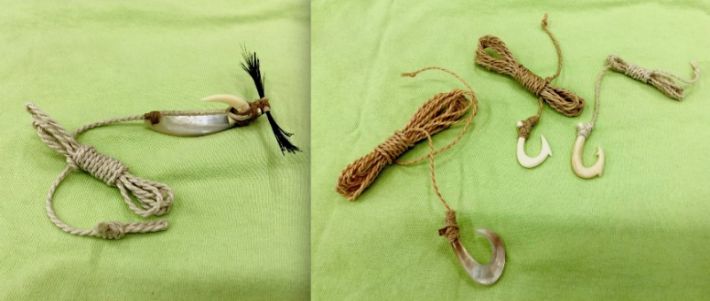In this Kūkahekahe Cultural Conversations story, KS Cultural Specialist and Kaʻiwakīloumoku carver Kumulaʻau Sing KSK’89 reflects on the ‘ike, or knowledge, passed down by his kumu Gordon ‘Umi Kai, a recognized ʻōlohe lua (master of traditional martial arts) and a respected cultural advisor.
In the Hawaiian language, the word “kumu” can refer to a teacher, mentor, tutor, and guide. The understood relationship between a teacher and student is eloquently explained in the ʻōlelo noʻeau, “He lālā au no kuʻu kumu”, which translates to I am a branch of the tree, I am a student of my teacher. In my years as a cultural practitioner, and throughout my career as an instructor and cultural arts specialist at Ka‘iwakīloumoku, I have been blessed with ʻike from many kumu who kālai, who carve and shape me, through their generous sharing of knowledge and mentorship. One such individual is Gordon ʻUmialīloalāhānauokalākaua Kai.
Kai is a well-respected practitioner and artisan in the Hawaiian community. A renaissance man, he is known as a master of producing traditional implements, from weapons that were used in war to the more utilitarian fishing tools. Kai is a recognized ʻōlohe lua (master of traditional martial arts) and a respected cultural advisor.
Most of all, Kai’s commitment to mentoring others over the last four decades has made him a father figure to many and he is frequently called ‘anakala (uncle). Kai can be considered a lawaiʻa, a fisherman: someone who creates his own functional fishing tools and implements, and who also uses resources gathered from the sea. But as a mentor, Kai can also be considered a “fisher of men,” someone whom we can emulate. In this realm, he has been an especially strong mentor and role model for Native Hawaiian kāne of all ages, not only in his knowledge and craftsmanship but also in his calm demeanor and patience as a teacher. Kai devotion to family and compassion for people are among the important lessons that have had an impact on me.
Kai was the first person to introduce me to the Hawaiian art of carving many years ago, and since then he has taught me so much more. In 2015, Kai was selected by the Native Arts and Cultures Foundation to launch a master-apprentice program to mentor and teach how to share knowledge with subsequent generations. Although I had already known Kai for fifteen years at that time, this was my first opportunity to learn from him personally, with a hands-on approach to cultural arts.
Using kumu’s neo-traditional methodology, our cohort learned how to create and lash various items such as mākau: fishhooks and lures using bone and shell, and mea kaua (war implements) with native wood and natural fiber cordage. From Kai, we learned to give attention to detail when creating those ancestral pieces. When we create traditional items, whether it is a replica of an artifact or a contemporary piece, the finished piece must be maiau (neat, clean and careful in work; skillful, expert; meticulous) because it should reflect the pride and ingenuity of our kūpuna. From this experience with Kai, I also learned what I feel was one of his great lessons; if you take initiative and responsibility in learning and apply what is taught, personal growth will surely follow.
Kumu ʻUmi has made great contributions to our lāhui; as an artist, his prolific body of material culture has reshaped the landscape of contemporary Hawaiian art and expanded the preservation and perpetuation of these arts to subsequent generations of artisans and practitioners. He has been honored for his life’s work as a 2017 Paʻi Foundation MAMo Awardee, a 2018 Hongpa Hongwanji Living Treasure, a 2019 OHA Living Treasure, and most recently as a 2021 First Peoples Fund Community Spirit Awardee.
I have had the privilege to work alongside and share ʻike with kumu at various cultural events.These events include the Celebration of the Arts Festival at the Ritz-Carlton Kapalua and the Hālauaola Hula Conference. Today, I continue to apply all that kumu ʻUmi Kai has taught and continues to share with me in my own journey. When I share the knowledge that he passed to me, I know that it will not only allow my haumāna to process information, but opportunities and freedom to safely explore experiences that will connect them to their ancestors: building self confidence and further strengthening their Hawaiian identity.
I conclude in sharing the ʻōlelo noʻeau, “Nānā i ke kumu,” which is translated as both look to the source and look to your teacher. It is with great pride that I claim Kai as my kumu, and I strive to carry the knowledge he has shared with me into my work and to my own students.

Various mākau made from 2015-2016 class, under the direction of Kai, using bone and shell with natural fiber cordage (hau).

A puʻu lei niho or warknuckle duster is a mea kaua (war instrument) used for slashing.

Various mea kaua (war instrument) made with ʻike taught by kumu ʻUmi Kai.
TAGS
cultural conversations,
kūkahekahe,
ho 'okahua,
martial arts
CATEGORIES
Kaipuolono Article, Regions, Themes, Culture, Community, Hawaii Newsroom, KS Hawaii Home, Kapalama Newsroom, Kapalama Home, Maui Newsroom, KS Maui Home, Newsroom, Campus Programs, Hawaii, Kapalama, Maui, Community Education, Department News
Print with photos
Print text only










